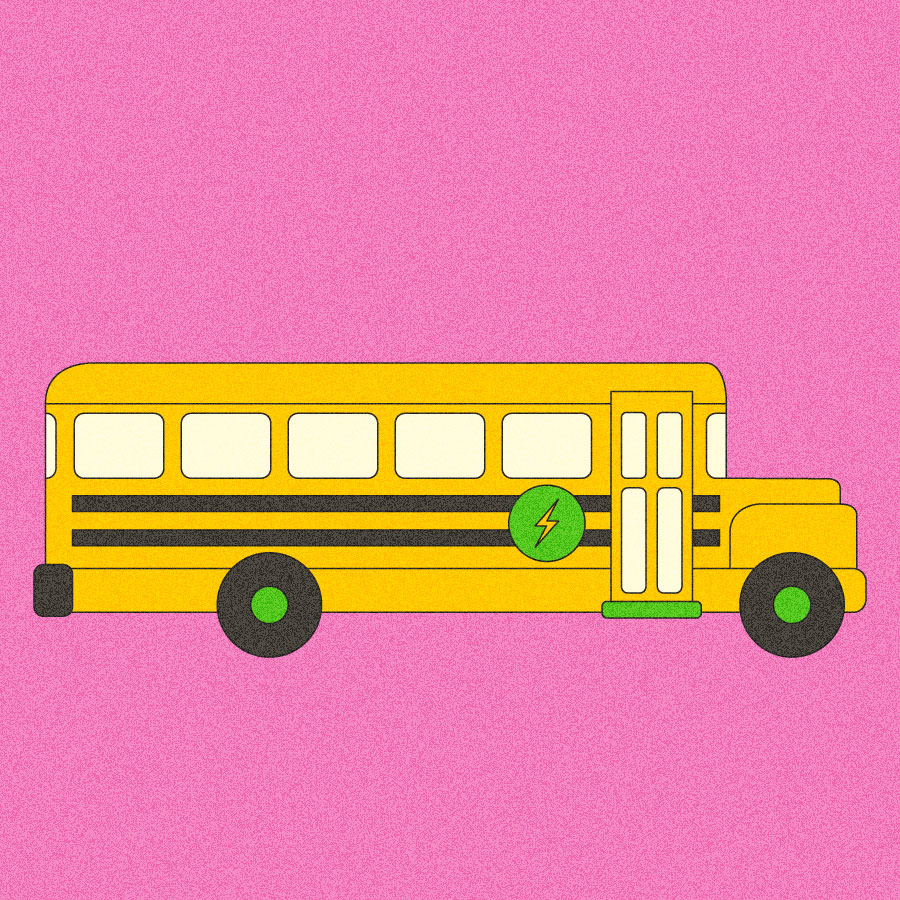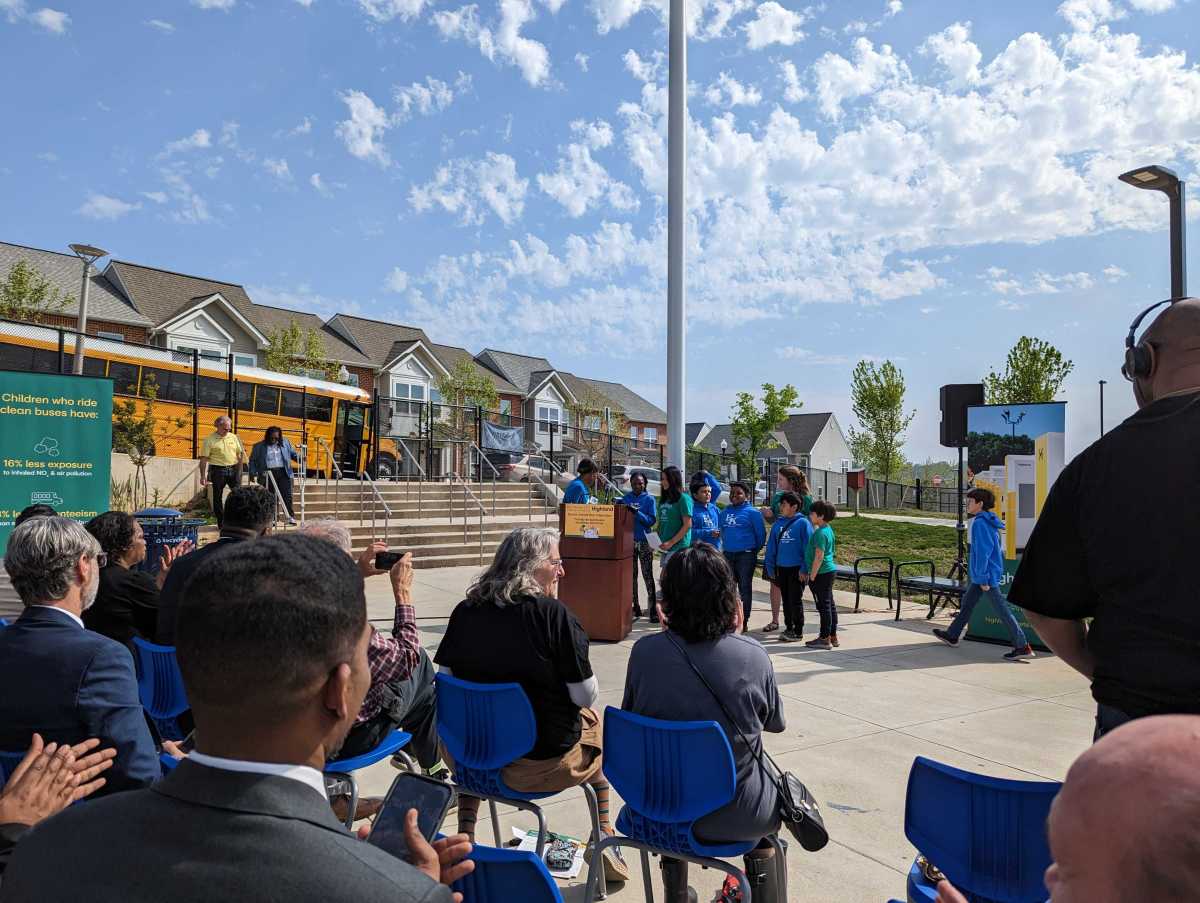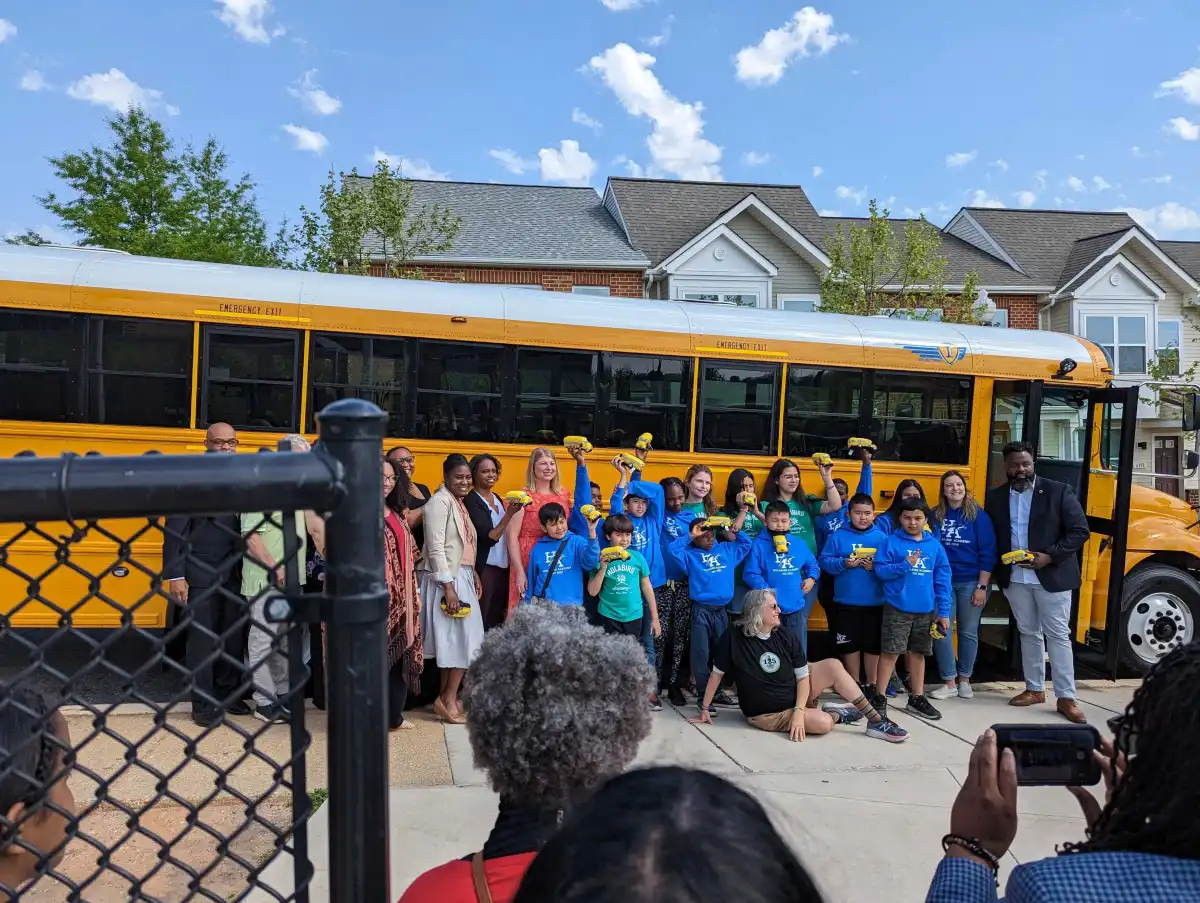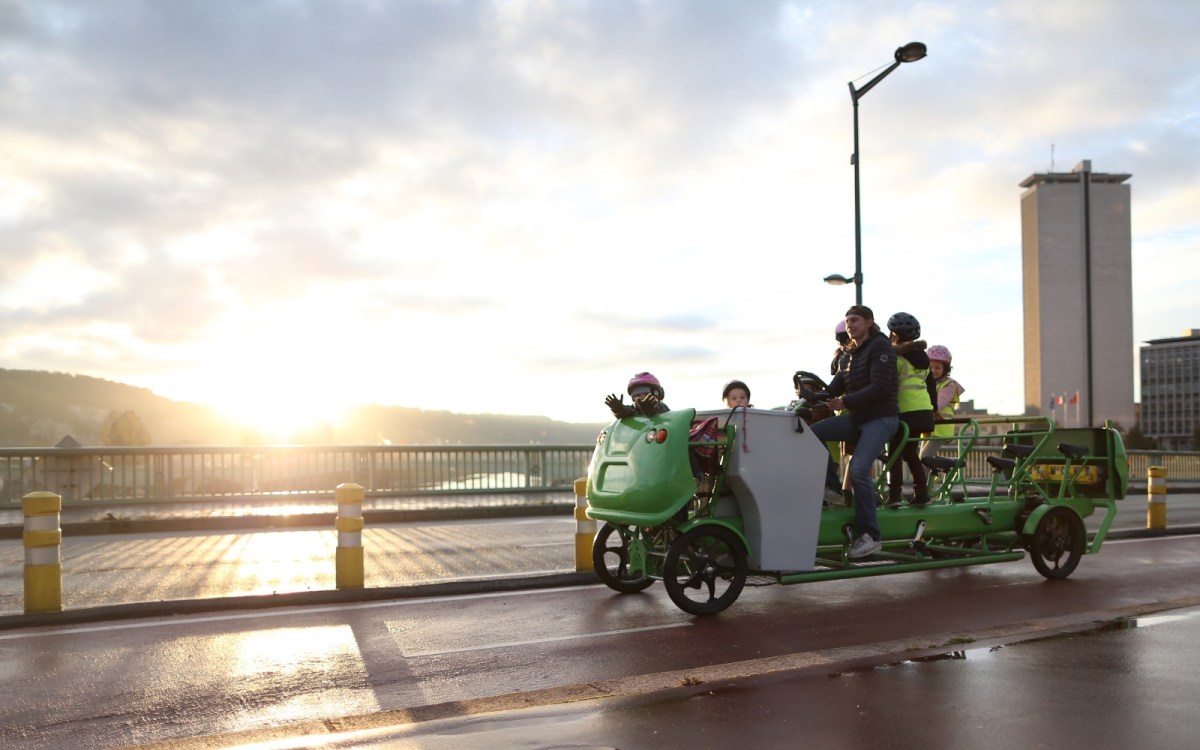
The spotlight
On Friday, April 21 — the day before Earth Day — students, teachers, city staff, sustainability advocates, and others gathered at Holabird Academy, an elementary and middle school in southeast Baltimore. The crowd was there to celebrate the announcement of a new initiative for the city: a pilot of 25 electric school buses, which will officially kick off later this school year.
Holabird was chosen for the occasion because it, too, is a relatively recent sustainability win for Baltimore — it’s one of two net-zero, LEED Platinum schools that opened in the city in 2020, nearly a decade in the making.
In the courtyard, blue plastic chairs were assembled facing a podium, which quickly filled up as people gathered to hear remarks from city leaders. And a large yellow bus sat parked on the hill above the school courtyard — familiar-looking, but with a twist: It was missing an exhaust pipe. The demo bus was provided for the day to give community members the chance to experience an electrified ride.

Students on Holabird Academy’s Green Team address the crowd at the event on April 21. Claire Elise Thompson / Grist
“This is a really big deal for Baltimore city,” Lynette Washington, then the chief operating officer for Baltimore City Schools, told the crowd at Holabird. “While there have been other school districts that have been doing electric buses, we haven’t had the opportunity to do it, because of access to resources. For us to have this access, and be able to participate in this type of initiative, it’s a big deal for Baltimore city.”
Transportation contributes more to greenhouse gas emissions than any other sector, and the nation’s 480,000 school buses make up its single largest public transportation fleet — a fleet that millions of children rely on to get to school safely (and far more efficiently than if every student were to drive on their own). But 90 percent of buses run on diesel fuel, and spew out diesel exhaust, which, in addition to being bad for the environment, is a known carcinogen.
Even in urban Baltimore, where most students are able to either walk or take public transit to school, about 305 yellow buses hit the streets every school day, each one averaging about an 80-mile route — and they primarily serve students with special needs.
![]()
Switching over to electric fleets has become a goal for many cities and school districts. As of June, there were 2,277 electric buses either on the streets or on order for school districts in the U.S., according to the World Resources Institute. And more than double that number are committed, meaning that school districts plan to continue electrifying their fleets.
Federal funding from the 2021 bipartisan infrastructure law has been crucial to this trend, largely because one of the biggest barriers to electrifying school bus fleets is the price tag. “The cost of an electric bus is about three times the cost of a diesel bus,” says Robbin Marshall, assistant director of student transportation for Baltimore City Public Schools.
Last fall, Baltimore received $9.4 million from the EPA’s Clean School Bus Program. It was one of nearly 400 school districts from across the country selected to receive funding for new buses, with a focus on underserved areas and those overburdened by pollution, in keeping with President Biden’s Justice40 goals.
For Baltimore, going electric wouldn’t have been possible without the help of the EPA grant. Although Maryland’s Climate Solutions Now Act of 2022 includes school bus electrification as a goal for the state, it wasn’t a practical consideration for Baltimore before the funding became available. “As soon as the opportunity came for us to get funding for it, it became a goal,” says Marshall.
But as Baltimore began consulting with other school districts before taking the leap to electrify its school bus fleet, even more challenges emerged. Among the school districts that had purchased electric buses, Marshall says, “Almost unanimously, the districts who did it on their own had some type of costly issue that prevented them [either] from getting the buses right away, or cost them more money for an issue that came up after the fact.”
![]()
Neighboring Montgomery County has the largest electric school bus project in the country, and it offers a different model for the switch to electric buses. Though the Washington, D.C., suburb is among the wealthiest counties in the nation, it still chose not to dive right into purchasing its own buses. Instead, the county partnered with a company called Highland Electric Fleets, which works with municipal partners to help manage the process of adopting this new technology.
Highland first helps school districts secure funding — by applying to the EPA grants, for instance — then buys the buses from EV manufacturers. And, working with cities over 10- to 15-year contracts, the company essentially provides electrification as a service, from the hardware of the buses themselves to the software that optimizes charging schedules. It is also responsible for all repairs and maintenance, although the company offers training so that cities can keep their existing staff and contracts. “I would call it a fully de-risked journey into electrification,” says Ben Schutzman, Highland’s chief operating officer.
Montgomery County has set its sights on a fully electric fleet within 10 years. For its initial pilot, the county has committed to swapping 326 of its buses to electric by 2025, and 86 are already running.
Montgomery was only Highland’s second customer when it launched its pilot in 2021, Schutzman says — the company’s first customer was Beverly, Massachusetts, with a single bus. “I think they got the second electric vehicle off of the production line,” Schutzman laughs. Highland has since grown rapidly, now working with over 30 customers in school districts large and small, which Schutzman believes mirrors the acceleration of EVs more broadly.
![]()
Baltimore is preparing to launch its own pilot, following its neighbor’s model and partnering with Highland. A depot with 25 charging stations was constructed this summer, with Highland’s help. Five of the buses (smaller Type A school buses) are due to be delivered this month, and 20 more (the classic Type C buses) will be coming in November. Highland will offer trainings for the drivers on best practices for things like maximizing energy efficiency, and then the buses can hit the road.
Marshall thinks the city may someday transition to owning the buses itself, both as EVs become less expensive and as the technology becomes more familiar. But working toward a fully electric fleet will depend on additional resources, he says, and also on how the buses perform. For instance, he has questions about range, and whether the batteries will be able to accommodate additional trips that buses sometimes need to make for field trips or athletic competitions.
“I think community benefits will be more of a long-term thing,” adds Marshall. “Because, you know, we’re talking about less emission fumes in the air. Mind you, 25 buses out of the hundreds of buses that are operating within the district’s contract is just kind of a small drop in the bucket.” City officials estimate that the 25 new buses will avoid over 6,000 gallons of diesel and 145 tons of CO2 per year.

Students on the Green Team and school district officials pose in front of an electric bus. Claire Elise Thompson / Grist
But there are also some immediate benefits that Marshall and others are keen to see when the buses hit their routes later this year. Back at Holabird, one of those benefits became clear when the crowd had the opportunity to ride around the block on the demo electric bus. As people boarded, somebody remarked that the bus was already on — a surprise, given how utterly quiet it was.
“Diesel buses are so loud,” Marshall says. “Kids almost have to scream at each other because they have to compete with the volume of the engine.” In addition to the reduction in air pollution, some advocates believe the reduced noise pollution is beneficial to children’s mental and physical well-being as they journey to and from school.
One student, Alexa, a fifth grader at Holabird last spring and a leader on the school’s Green Team, shared with the crowd why she was proud of the city’s initiative. “I think it’s really cool that our school system will be getting electric buses,” she said. “In my sustainability class, we have learned about the harmful effects of air pollution, and I am so excited to know that our city is trying to decrease its carbon footprint.”
— Claire Elise Thompson
More exposure
- Read: more about the EPA’s clean school bus grant program (Grist)
- Read: more about the growth of school bus electrification, with helpful graphics (Canary Media)
- Watch: a short video exploring the benefits and challenges of electric school buses (CNBC)
- Read: why buses are “among the most overlooked solutions for decarbonizing the U.S.” (Scientific American)
- Read: how rickshaws, a ubiquitous form of transportation across many Asian countries, are rapidly electrifying (The Atlantic)
A parting shot
Not to be outdone, European cities have pioneered another clean mode of school transportation: bike buses. They can range from huge convoys of children on various two-wheeled vehicles, guided by parent volunteers and local police, to specialized vehicles like the “S’Cool Bus,” pictured below in northwestern France. It’s a big tandem e-bike, crewed by about nine children and an adult “driver.”




